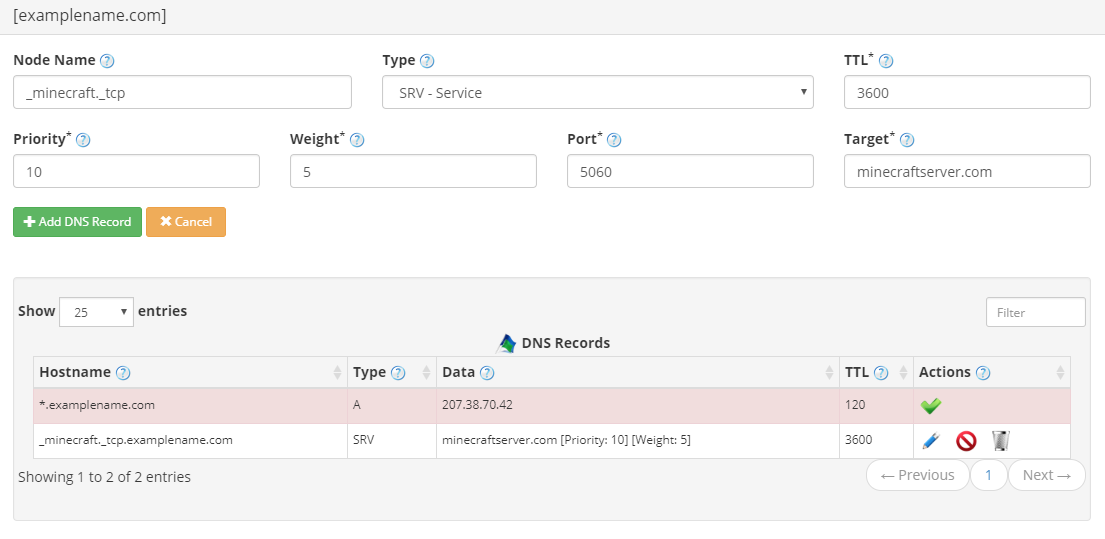Dynu gives you full control over all the DNS configurations for your domain names.
You can log onto the control panel to manage your DNS records.
SRV record allows multiple servers providing a similar TCP/IP-based service to be located using a single DNS query operation. This record enables you to maintain a list of servers for a well-known server port and transport protocol type ordered by preference for a DNS domain name. The naming system of SRV record is an underscore followed by the name of the service, followed by a period, and underscore, and then the protocol, another period, and then the name of the domain. For example, _http._tcp.yourdomain.com would be the service record for web requests for yourdomain.com.
To add an SRV record in the control panel, you may follow these 3 steps.
 Step 2
Step 2
Go to DNS Records
to add an SRV Record.
DNS Records
to add an SRV Record.
Node Name _service._protocol.sub. For example, _minecraft._tcp.sub. The service name is minecraft, the protocol is tcp and the record is for sub.examplename.com. Use _service._protocol only if the record is for the primary domain. For example, _minecraft._tcp like shown in the screenshot below.
Type Choose "SRV-Service".
TTL How long the server should cache the information.
Priority Sets the preference for a host specified in the Target field. The lower the number, the higher the priority. The range of preference values is 0 to 65535.
Weight Used in addition to Priority to provide a load-balancing system where multiple servers are specified in Target field and are all set to the same level of preference. It is a relative weight for records with the same priority, a higher value means more preferred. If load balancing is not needed, use a value of 0.
Port The server port on the target host that provides the service. For example, 80 for http.
Target It specifies the DNS domain name of the host that provides the type of service being requested.

 Step 3
Step 3
Check if your SPF record has gone into effect using DNS Lookup tool. Enter _minecraft._tcp.examplename.com as Hostname, and choose "SRV-Service" as Type.
What is an SRV record?
SRV record allows multiple servers providing a similar TCP/IP-based service to be located using a single DNS query operation. This record enables you to maintain a list of servers for a well-known server port and transport protocol type ordered by preference for a DNS domain name. The naming system of SRV record is an underscore followed by the name of the service, followed by a period, and underscore, and then the protocol, another period, and then the name of the domain. For example, _http._tcp.yourdomain.com would be the service record for web requests for yourdomain.com.
How to add an SRV record?
To add an SRV record in the control panel, you may follow these 3 steps.
Go to
Node Name _service._protocol.sub. For example, _minecraft._tcp.sub. The service name is minecraft, the protocol is tcp and the record is for sub.examplename.com. Use _service._protocol only if the record is for the primary domain. For example, _minecraft._tcp like shown in the screenshot below.
Type Choose "SRV-Service".
TTL How long the server should cache the information.
Priority Sets the preference for a host specified in the Target field. The lower the number, the higher the priority. The range of preference values is 0 to 65535.
Weight Used in addition to Priority to provide a load-balancing system where multiple servers are specified in Target field and are all set to the same level of preference. It is a relative weight for records with the same priority, a higher value means more preferred. If load balancing is not needed, use a value of 0.
Port The server port on the target host that provides the service. For example, 80 for http.
Target It specifies the DNS domain name of the host that provides the type of service being requested.

Check if your SPF record has gone into effect using DNS Lookup tool. Enter _minecraft._tcp.examplename.com as Hostname, and choose "SRV-Service" as Type.
